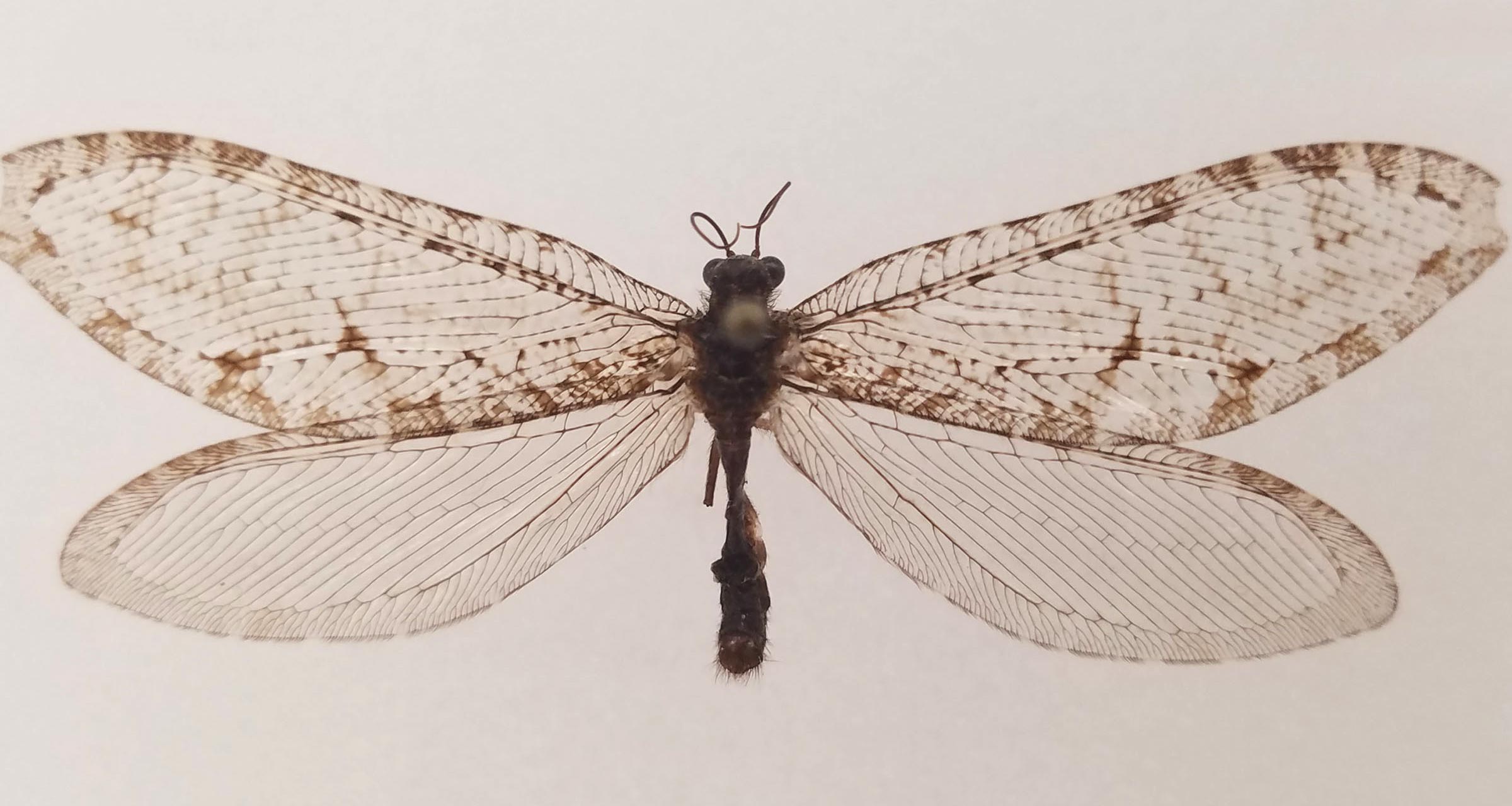esse Polystoecotes punctata Ou a lagarta gigante coletada em Fayetteville, Arkansas, em 2012, por Michael Skvarla, diretor do Laboratório de Identificação de Insetos da Penn State. Este espécime é o primeiro de seu tipo a ser registrado no leste da América do Norte em mais de cinquenta anos – e o primeiro registro desta espécie no estado. Crédito: Michael Skvarla/Penn State
A recente identificação de rendas gigantes aponta para questões ecológicas mais profundas.
Um inseto gigante arrancado da frente de um Walmart do Arkansas estabeleceu recordes históricos. o Polystoecotes punctata ou crisopídeo gigante é o primeiro de seu tipo registrado no leste da América do Norte em mais de 50 anos – e o primeiro registrado[{” attribute=””>species ever in the state.
The giant lacewing was formerly widespread across North America, but was mysteriously extirpated from eastern North America by the 1950s. This discovery suggests there may be relic populations of this large, Jurassic-Era insect yet to be discovered, explained Michael Skvarla, director of Penn State’s Insect Identification Lab.
Skvarla found the specimen in 2012, but misidentified it and only discovered its true identity after teaching an online course based on his personal insect collection in 2020. He recently co-authored a paper about the discovery in the scientific journal Proceedings of the Entomological Society of Washington.
“I remember it vividly, because I was walking into Walmart to get milk and I saw this huge insect on the side of the building,” said Skvarla, who was a doctoral student at the University of Arkansas at the time. “I thought it looked interesting, so I put it in my hand and did the rest of my shopping with it between my fingers. I got home, mounted it, and promptly forgot about it for almost a decade.”
It wasn’t until the COVID-19 pandemic that the giant lacewing would find its time to shine. In the fall of 2020, with the world in lockdown, Skvarla was teaching Entomology 432: Insect Biodiversity and Evolution at Penn State. He taught the lab course via Zoom, with students following along remotely on loaner microscopes, and used his own personal insect collection as specimen samples.
As he went to demonstrate the features of a specimen he had previously labeled an “antlion,” Skvarla noticed that the characteristics didn’t quite match those of the dragonfly-like predatory insect. Instead, he thought it looked more like a lacewing. A giant lacewing has a wingspan of roughly 50 millimeters, which is quite large for an insect, a clear indicator that the specimen was not an antlion, as Skvarla had mistakenly labeled it. The students got to work comparing features — and a discovery was made, live on Zoom.
“We were watching what Dr. Skvarla saw under his microscope and he’s talking about the features and then just kinda stops,” said Codey Mathis, a doctoral candidate in entomology at Penn State. “We all realized together that the insect was not what it was labeled and was in fact a super-rare giant lacewing. I still remember the feeling. It was so gratifying to know that the excitement doesn’t dim, the wonder isn’t lost. Here we were making a true discovery in the middle of an online lab course.”
For additional confirmation, Skvarla and his colleagues performed molecular DNA analyses on the specimen. Since confirming its true identity, Skvarla has deposited the insect safely in the collections of the Frost Entomological Museum at Penn State, where scientists and students will have access to it for further research.
“It was one of those experiences you don’t expect to have in a prerequisite lab course,” Louis Nastasi, a doctoral candidate studying entomology at Penn State. “Here we were, just looking at specimens to identify them, and all of a sudden, out of nowhere, this incredible new record pops up.”
Discovery or recovery?
The fact that a giant lacewing was spotted in the urban area of Fayetteville, Arkansas may reveal a larger story about biodiversity and a changing environment, Skvarla explained. He said that explanations vary for the giant lacewing’s disappearance from North America — and it still largely remains a mystery.
Scientists hypothesize the insect’s disappearance could be due to the ever-increasing amount of artificial light and pollution of urbanization; suppression of forest fires in eastern North America, if the insects rely on post-fire environments; the introduction of non-native predators such as large ground beetles; and introduction of non-native earthworms, which significantly altered the composition of forest leaf litter and soil.
“Entomology can function as a leading indicator for ecology,” Skvarla said. “The fact that this insect was spotted in a region that it hasn’t been seen in over half a century tells us something more broadly about the environment.”
The researchers analyzed extensive collection records of giant lacewings, including museum holdings and community science submissions, and placed them into a single map to determine their distribution. The records span a huge geographic range, from Alaska to Panama, and include multiple ecoregions in both eastern and western North America. The map revealed the Arkansas specimen was the first spotted in eastern North America in over 50 years.
Fayetteville lies within the Ozark Mountains, which are a suspected biodiversity hotspot, according to Skvarla and his co-author J. Ray Fisher of the Mississippi Entomological Museum at Mississippi State University.
They said that dozens of endemic species, including 68 species of insects, are known from the Ozarks and at least 58 species of plants and animals have highly disjunct populations with representatives in the region. They explain that the area is understudied compared to regions of similar biodiversity, such as the Southern Appalachians.
“This combination makes the region an ideal place for a large, showy insect to hide undetected,” they said.
The mystery remains as to how the insect arrived on the exterior of a Walmart. The fact that it was found on the side of a well-lit building at night suggests that it was likely attracted to the lights and may have flown at least a few hundred meters from where it originated, Skvarla explained. “It could have been 100 years since it was even in this area — and it’s been years since it’s been spotted anywhere near it. The next closest place that they’ve been found was 1,200 miles away, so very unlikely it would have traveled that far.”
The researchers note that they suspect the new specimen represents a rare, surviving eastern population of giant lacewings that evaded detection and extinction.
“Discovery doesn’t always hold that same kind of grasp on people that maybe it did 100 years ago,” said Nastasi. “But a finding like this really highlights that even in a run-of-the-mill situation, there are still a tremendous number of discoveries to make about insects.”
Reference: “Rediscovery of Polystoechotes punctata (Fabricius, 1793) (Neuroptera: Ithonidae) in Eastern North America” by Michael J. Skvarla and, J. Ray Fisher, 30 November 2022, Proceedings of the Entomological Society of Washington.
DOI: 10.4289/0013-8797.124.2.332

“Criador. Viciado em mídia social que gosta de hipster. Fã da web. Fanático por álcool apaixonado.”











More Stories
A Boeing pode não conseguir operar o veículo Starliner antes que a estação espacial seja destruída
Vivendo com ansiedade: conselhos de especialistas sobre como aceitar um problema de saúde mental
Nova pesquisa sobre uma enorme falha de impulso sugere que o próximo grande terremoto pode ser iminente